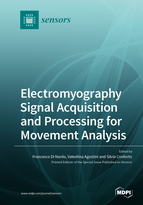Electromyography Signal Acquisition and Processing for Movement Analysis
A special issue of Sensors (ISSN 1424-8220). This special issue belongs to the section "Biosensors".
Deadline for manuscript submissions: closed (30 June 2022) | Viewed by 59912
Special Issue Editors
Interests: biomedical signal processing (filtering, feature extraction, pattern recognition, time–frequency analysis, machine learning applications); interpretation (clinics, rehabilitation, sport); acquisition and processing of surface electromyography (EMG) signals to assess muscular function during gait tasks
Special Issues, Collections and Topics in MDPI journals
Interests: human motion analysis; motion tracking; gait analysis; wearable sensors; surface electromyography (EMG); motor control; biomechanics; neurorehabilitation; muscle synergies; medical signal processing
Special Issues, Collections and Topics in MDPI journals
Special Issue Information
Dear Colleagues,
The assessment of muscle recruitment is acknowledged as one of the main issues of movement analysis. Muscle activity is typically monitored by surface electromyography (sEMG), a non-invasive technique widely adopted both in research and clinical settings. Recent advancements in commercial EMG signal acquisition technologies and sensors, the development of high-density surface EMG systems, the introduction of sensor fusion, and the availability of data storage and file sharing systems have changed the perspective about measuring, capturing, and analysing EMG signals, specifically in movement analysis. The areas of application are also increasing and differentiating. Besides typical fields such as basic research, clinics, and sports, EMG analysis is increasingly proposed in novel scenarios related to robotics, exoskeleton technology, prosthetics, assistive devices, electrical stimulation, and ergonomics.
The present Special Issue is designed to comprehensively cover the open research issues related to the improvement of classic approaches and the development of innovative technology and methodology for EMG signal acquisition and processing in the domain of movement analysis. Furthermore, the Special Issue aims to also focus on different fields of application of EMG analysis, including clinics, physiology, rehabilitation, sports, and ergonomics. Computational intelligence methods, such as machine and deep learning, have recently emerged as promising tools for the development and application of intelligent systems in interpreting EMG signals, and contributions on this field are also welcome.
This Special Issue includes, but is not limited to, the following topics:
- Surface EMG
- EMG sensors
- EMG modelling
- EMG feature extraction
- EMG pattern recognition
- High-density surface EMG
- Machine and deep learning for EMG-based classification
- EMG in clinical gait analysis
- EMG analysis and interpretation for motor rehabilitation
- EMG in sports and exercise
Dr. Francesco Di Nardo
Dr. Valentina Agostini
Prof. Dr. Silvia Conforto
Guest Editors
Manuscript Submission Information
Manuscripts should be submitted online at www.mdpi.com by registering and logging in to this website. Once you are registered, click here to go to the submission form. Manuscripts can be submitted until the deadline. All submissions that pass pre-check are peer-reviewed. Accepted papers will be published continuously in the journal (as soon as accepted) and will be listed together on the special issue website. Research articles, review articles as well as short communications are invited. For planned papers, a title and short abstract (about 100 words) can be sent to the Editorial Office for announcement on this website.
Submitted manuscripts should not have been published previously, nor be under consideration for publication elsewhere (except conference proceedings papers). All manuscripts are thoroughly refereed through a single-blind peer-review process. A guide for authors and other relevant information for submission of manuscripts is available on the Instructions for Authors page. Sensors is an international peer-reviewed open access semimonthly journal published by MDPI.
Please visit the Instructions for Authors page before submitting a manuscript. The Article Processing Charge (APC) for publication in this open access journal is 2600 CHF (Swiss Francs). Submitted papers should be well formatted and use good English. Authors may use MDPI's English editing service prior to publication or during author revisions.
Keywords
- surface EMG
- movement analysis
- EMG sensors
- biomedical signal processing
- muscle recruitment








